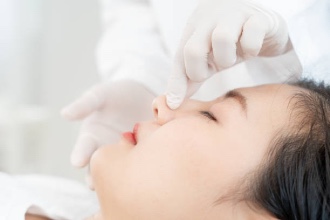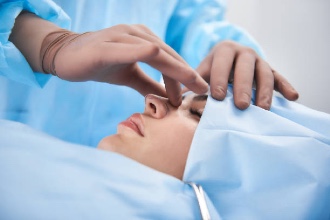
Thinking about changing the shape of your nose? For easier breathing, increased confidence, or both—rhinoplasty, or a nose job, is one of the most popular cosmetic surgeries all over the world.
What Is Rhinoplasty?
Rhinoplasty is a surgical procedure that reconstructs the shape or size of the nose. It is done to fix bumps or curves, make the nose smaller, reshape the tip, or straighten the bridge. Others need it to correct breathing problems caused by a crooked septum. Rhinoplasty can be done for cosmetic reasons, medical reasons, or a combination of both.
Why Do People Get It?
To improve their appearance
To correct an injury or defect
To fix breathing problems,
To boost self-confidence
Everyone’s nose and goals are different, so a good surgeon will design the surgery based on your unique face and needs.
How Is Rhinoplasty Done?
Rhinoplasty is normally performed under general anesthesia, meaning you’ll be asleep and won’t feel anything during the procedure. The surgery typically takes 1 to 2 hours.
Open Rhinoplasty: A cut is made under the nose to allow the surgeon to pull back the skin and operate on the bone and cartilage.
Closed Rhinoplasty: All incisions are made inside the nose—no visible scars.
The surgeon can re-shape the bones, add cartilage, or reshape the nasal tip. If you also have difficulty breathing, they may also correct the septum (septoplasty).
What’s the Recovery Process?
Right After Surgery: You’ll have a splint on your nose to keep it in place. Your eyes and nose will swell and bruise, particularly the first week. You'll be stuffy—like you have a bad cold—but that gets better in a few days.
1 Week Later: The splint and stitches will be typically removed. Bruising will begin to subside. You may resume your daily activities but no heavy exercises yet.
1 Month Later: Swelling will improve, and the nose will start to look more natural. Light exercise will be acceptable, but continue to avoid contact sports.
3–6 Months Later: Most of the swelling will be gone. You’ll see the final shape starting to settle.
1 Year Later: Final results. It takes up to a year for all internal swelling to go down and for your new nose shape to fully appear.
Does It Hurt?
Most individuals report rhinoplasty is not particularly painful. You may experience pressure, stuffiness, or discomfort, but it is generally easy to manage with pain medication.
What to Do Prior to Rhinoplasty
Consult a qualified surgeon: Select a board certified, experienced plastic surgeon. Discuss your medical history and goals.
Get medical tests if needed: The doctor may ask for blood tests or a physical exam to make sure you're fit for surgery.
Stop smoking at least 2 weeks in advance: Smoking decreases circulation and delays healing.
Prepare your home for recovery: Have ice packs, soft foods, comfy pillows, and any prescribed medications ready in advance.
Arrange someone to take you home and help for the first 24–48 hours.
What Not to do Before Rhinoplasty
Don’t eat or drink anything after midnight the night before surgery if under general anesthesia. Don’t wear makeup, nail polish, or contact lenses on surgery day. Don’t skip your pre-op instructions from your doctor.
What to Do After Rhinoplasty
Keep your head elevated even during sleep: Use extra pillows or sleep in a recliner to minimize swelling.
Apply cold compresses carefully (across cheeks, not over the nose itself): This helps swelling and bruising in the initial 2–3 days.
Take medications as prescribed: Painkillers and antibiotics help manage discomfort and prevent infection.
Keep the surgical area clean and dry: Follow your doctor's cleaning and care routine carefully.
Eat soft foods and stay hydrated: Chewing too much can put pressure on your healing nose.
Be patient with swelling: It can take months for the final shape to fully settle.
What Not to Do After Rhinoplasty
Avoid blowing your nose for at least 2–3 weeks. If you need to sneeze, sneeze through an open mouth.
Don’t wear glasses for about 4–6 weeks—they can leave dents on your nose.
Don’t do heavy exercise or bend over for at least 3–4 weeks.
Keep the nose dry (no hot showers over the face or swimming) until your doctor says it is safe.
Avoid alcohol and smoking when recovering—it slows healing.
Don’t judge your results too early: Swelling takes time to fully go down.
Why Choose Via Premium Travel?
Via Premium Travel partners only with certified, experienced, and internationally recognized plastic surgeons. Whether you want a natural refinement or a dramatic change, we match you with the right specialist who understands both beauty and function.
With us, you're able to book your surgery within a few weeks or earlier. This is ideal for those who want to plan treatment around their schedule.
We offer all-inclusive medical travel packages that include: Consultation and surgery, hotel stay, tanslators, medication and aftercare guidance.
So, while we handle everything, you’ll have plenty of time to focus on healing. Our team is on hand from the minute you arrive to your last check-up to assist with translation, questions, or concerns. We offer straightforward communication, precise planning, and realistic expectations—so you always know what's going on.


Other Posts
 Knee Implants: A Simple Guide
Knee Implants: A Simple Guide
 What Is Rhinoplasty? A Complete Guide to Nose Reshaping Surgery
What Is Rhinoplasty? A Complete Guide to Nose Reshaping Surgery
 Weekly Developments in Medicine No: 1
Weekly Developments in Medicine No: 1
 Varicose Veins 101: Causes, Symptoms, and Treatment Options
Varicose Veins 101: Causes, Symptoms, and Treatment Options
 Step-by-Step: The IVF Process Explained
Step-by-Step: The IVF Process Explained
 The Beginnings of the Practice of Medicine in Greek Mythology
The Beginnings of the Practice of Medicine in Greek Mythology
 Hopeful Futures: How We Deliver Miracles
Hopeful Futures: How We Deliver Miracles
 A Comprehensive Guide to Urinary and Reproductive Health
A Comprehensive Guide to Urinary and Reproductive Health
 The Ultimate Guide to Hair Transplants: What You Need to Know
The Ultimate Guide to Hair Transplants: What You Need to Know
 Annual Checkups: Protect Your Health in Advance
Annual Checkups: Protect Your Health in Advance








